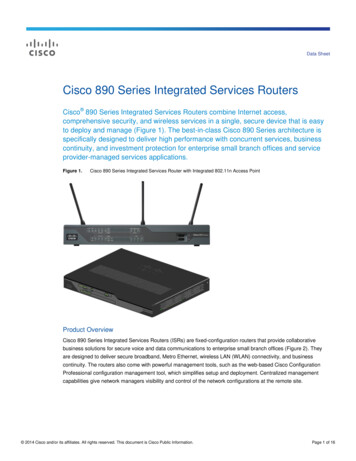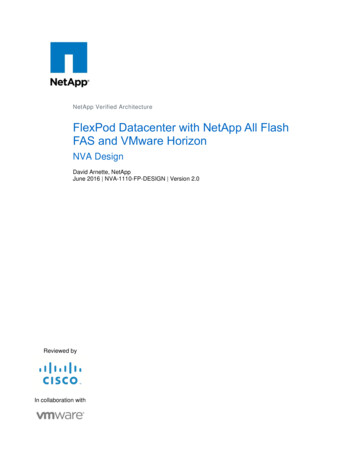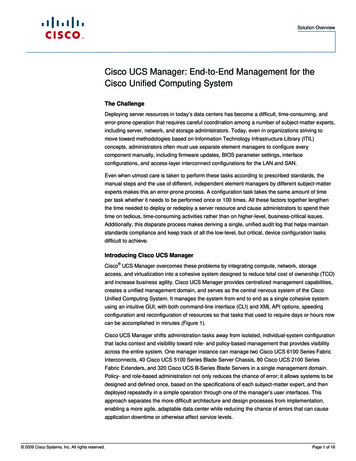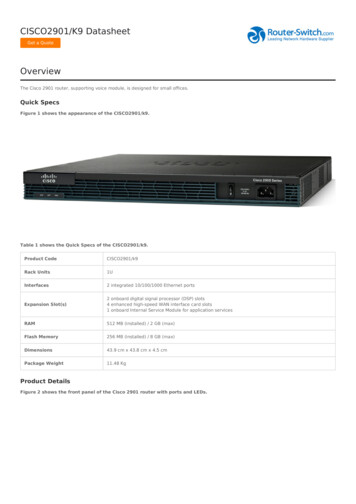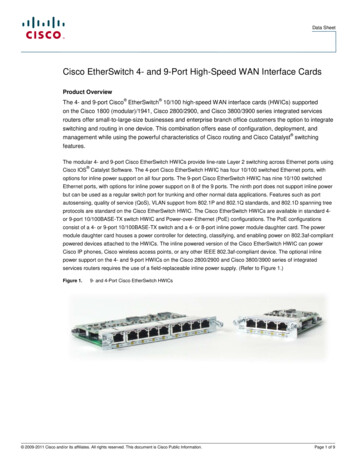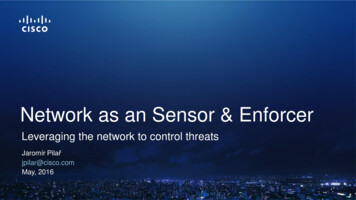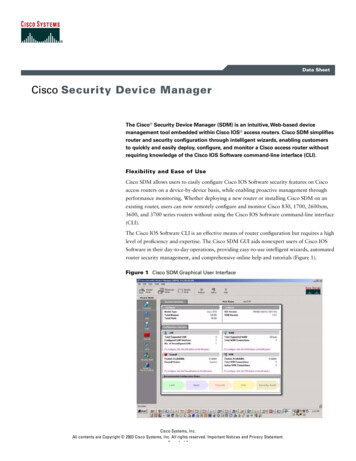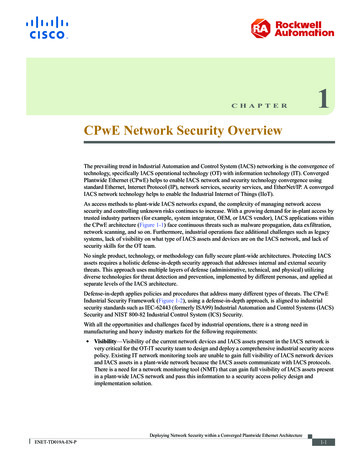
Transcription
CHAPTER1CPwE Network Security OverviewThe prevailing trend in Industrial Automation and Control System (IACS) networking is the convergence oftechnology, specifically IACS operational technology (OT) with information technology (IT). ConvergedPlantwide Ethernet (CPwE) helps to enable IACS network and security technology convergence usingstandard Ethernet, Internet Protocol (IP), network services, security services, and EtherNet/IP. A convergedIACS network technology helps to enable the Industrial Internet of Things (IIoT).As access methods to plant-wide IACS networks expand, the complexity of managing network accesssecurity and controlling unknown risks continues to increase. With a growing demand for in-plant access bytrusted industry partners (for example, system integrator, OEM, or IACS vendor), IACS applications withinthe CPwE architecture (Figure 1-1) face continuous threats such as malware propagation, data exfiltration,network scanning, and so on. Furthermore, industrial operations face additional challenges such as legacysystems, lack of visibility on what type of IACS assets and devices are on the IACS network, and lack ofsecurity skills for the OT team.No single product, technology, or methodology can fully secure plant-wide architectures. Protecting IACSassets requires a holistic defense-in-depth security approach that addresses internal and external securitythreats. This approach uses multiple layers of defense (administrative, technical, and physical) utilizingdiverse technologies for threat detection and prevention, implemented by different personas, and applied atseparate levels of the IACS architecture.Defense-in-depth applies policies and procedures that address many different types of threats. The CPwEIndustrial Security Framework (Figure 1-2), using a defense-in-depth approach, is aligned to industrialsecurity standards such as IEC-62443 (formerly ISA99) Industrial Automation and Control Systems (IACS)Security and NIST 800-82 Industrial Control System (ICS) Security.With all the opportunities and challenges faced by industrial operations, there is a strong need inmanufacturing and heavy industry markets for the following requirements: Visibility—Visibility of the current network devices and IACS assets present in the IACS network isvery critical for the OT-IT security team to design and deploy a comprehensive industrial security accesspolicy. Existing IT network monitoring tools are unable to gain full visibility of IACS network devicesand IACS assets in a plant-wide network because the IACS assets communicate with IACS protocols.There is a need for a network monitoring tool (NMT) that can gain full visibility of IACS assets presentin a plant-wide IACS network and pass this information to a security access policy design andimplementation solution.Deploying Network Security within a Converged Plantwide Ethernet ArchitectureENET-TD019A-EN-P1-1
Chapter 1CPwE Network Security OverviewNoteCisco and Rockwell Automation recommend that the OT-IT security team be composed of amulti-discipline team of operations, engineering, safety, maintenance, and IT representatives todevelop an industrial security access policy based on your risk tolerance and risk management. Segmentation—Segmentation (zoning) is an important piece of network architecture required by theOT-IT network design team for improving security and performance by grouping and separating networkassets. Cyber criminals study ways to infiltrate the IACS network by looking at the most vulnerablepoint. Segmentation helps to prevent the spread of the infection and limits it only to those endpoints thatan infected host can reach. A common segmentation method adopted by industrial operations is tosegment the IACS network Industrial Zone (Figure 1-1) from the Enterprise Zone via an industrial DMZ(IDMZ), then use logical segmentation within that zone (following the IEC 62443-3-2 Zones andConduits model). OT-IT then collaborates to design the access policy in the Industrial Zone by usingaccess control lists (ACLs). However, the management of ACLs can be tedious and their larger size canaffect the performance of network devices. Industrial operations are looking for a better solution tosegment access control policies for the IACS network Industrial Zone that is easier to deploy andmanage. Anomaly detection and Mitigation—When little to no access control methods to a plant-widearchitecture are enabled, the possibility of IACS assets getting infected increases. When such an eventhappens, the OT-IT security teams need to identify the infected device, then based on the OT-IT industrialsecurity access policy, decide how to address the threat based on the level of risk. Industrial operationsneed a method to detect anomalies, have the option to block threats, and identify compromised IACSassets. This detection and remediation method deployed in the plant-wide IACS network by the OT-ITteam must be scalable and also should not change the currently deployed architecture. Intent-based security for OT—In many industrial operations, IT helps to defines industrial securitypolicies, architecture, and design. OT depends on IT to enable and manage those policies. However,given that OT requirements are often fluid, the OT-IT security team needs a process that allows OT toexpress operational intent that results in dynamic industrial security access policy changes withouthaving to depend on IT. For example, consider the network security use case associated with remoteaccess. The IT team can create the general centralized access policy for remote access that has rules toallow a remote trusted industry partner expert to connect to an IACS asset. When the remote access is nolonger needed, the OT team informs IT to revoke the access for the remote expert. Since this process ismanual, in some cases there might be delays in providing or revoking the remote access. To overcomethese challenges, an automated self-service process is needed where an OT engineer can request theremote access without IT intervention.CPwE is the underlying architecture that provides standard network and security services for control andinformation disciplines, devices, and equipment found in modern IACS applications. The CPwE architectures(Figure 1-1) provide design and implementation guidance, test results, and documented configuration settingsthat can help to achieve the real-time communication, reliability, scalability, security, and resiliencyrequirements of modern IACS applications.CPwE Network Security describes several network security use cases that are solved using diverse securitysolutions and technologies. CPwE Network Security is brought to market through a strategic alliance betweenCisco and Rockwell Automation.Deploying Network Security within a Converged Plantwide Ethernet Architecture1-2ENET-TD019A-EN-P
Chapter 1Figure 1-1CPwE Network Security OverviewCPwE ArchitectureThere are many personae managing the plant-wide security architecture, with diverse technologies, as shownin Figure 1-2. Control System Engineers (highlighted in tan)—IACS asset hardening (for example, physical andelectronic), infrastructure device hardening (for example, port security), network monitoring and changemanagement, network segmentation (trust zoning), industrial firewalls (with inspection) at the IACSapplication edge, and IACS application authentication, authorization, and accounting (AAA). Control System Engineers in collaboration with IT Network (highlighted in blue)—Computer hardening(OS patching, application white listing), network device hardening (for example, access control,resiliency), network monitoring and inspection, and wired and wireless LAN access policies. IT Security Architects in collaboration with Control Systems Engineers (highlighted in purple)—Identityand Mobility Services (wired and wireless), network monitoring with anomaly detection, ActiveDirectory (AD), Remote Access Servers, plant firewalls, and Industrial Demilitarized Zone (IDMZ)design best practices.Deploying Network Security within a Converged Plantwide Ethernet ArchitectureENET-TD019A-EN-P1-3
Chapter 1CPwE Network Security OverviewCPwE Security OverviewFigure 1-2CPwE Industrial Security FrameworkCPwE Security OverviewProtecting IACS assets requires a defense-in-depth security approach where different solutions are needed toaddress different network and security requirements for a plant-wide architecture. This section summarizesthe existing Cisco and Rockwell Automation CPwE security CVDs and CRDs that address different aspectsof industrial security. Deploying Identity and Mobility Services within a Converged Plantwide Ethernet Architecture Designand Implementation Guide outlines several industrial security and mobility architecture use cases, withCisco ISE, for designing and deploying mobile devices, with FactoryTalk applications, throughout aplant-wide IACS network infrastructure.– Rockwell Automation groups/literature/documents/td/enet-td008 -en-p.pdf– Cisco s/Verticals/CPwE/3-5-1/ISE/DIG/CPwE ISE CVD.html Cloud Connectivity to a Converged Plantwide Ethernet Architecture Application Guide outlines severalindustrial security architecture use cases for designing and deploying restricted end-to-end outboundconnectivity with FactoryTalk software from the machine to the enterprise to the cloud within a CPwEarchitecture.– Rockwell Automation /groups/literature/documents/td/enet-td017 -en-p.pdfDeploying Network Security within a Converged Plantwide Ethernet Architecture1-4ENET-TD019A-EN-P
Chapter 1CPwE Network Security OverviewCPwE Network Security Solution Use Cases– Cisco ns/Verticals/CPwE/5-1/Cloud/DIG/CPwE Cloud Connect CVD.html Securely Traversing IACS Data Across the Industrial Demilitarized Zone Design and ImplementationGuide details design considerations to help with the successful design and implementation of an IDMZto securely share IACS data across the IDMZ.– Rockwell Automation groups/literature/documents/td/enet-td009 -en-p.pdf– Cisco ns/Verticals/CPwE/3-5-1/IDMZ/DIG/CPwE IDMZCVD.html Deploying Industrial Firewalls within a Converged Plantwide Ethernet Architecture Design andImplementation Guide outlines several use cases for designing, deploying, and managing industrialfirewalls throughout a plant-wide IACS network. The Industrial Firewall is ideal for IACS applicationsthat need trusted zone segmentation.– Rockwell Automation groups/literature/documents/td/enet-td002 -en-p.pdf– Cisco htmlCPwE Network Security Solution Use CasesThere are four network security solution use cases that are addressed by CPwE Network Security: Visibility and Identification of network devices and IACS assets in Cell/Area Zone(s). Security Group Policy segmentation of IACS assets in Industrial Zone (Level 3 Site Operations andCell/Area Zone(s)). Network flow and threat (e.g., malware) detection of network devices and IACS assets in the IndustrialZone. OT managed remote user (employee, partner) access (enterprise, internet) for network devices and IACSassets in the Industrial Zone.These network security solution use cases apply to both brown field (legacy) and green field (new)deployments and follow the best practice framework of CPwE.Deploying Network Security within a Converged Plantwide Ethernet ArchitectureENET-TD019A-EN-P1-5
Chapter 1CPwE Network Security OverviewCPwE Network Security Solution Use CasesVisibilityIACS asset and network device visibility is a continuous process of discovering and identifying all thedifferent IACS assets in the plant-wide network. From the industrial security perspective, it is imperative tohave visibility of the IACS assets and network devices due to the following reasons: Gaining the visibility of all the IACS assets would allow an OT-IT security administrative team tologically group these IACS assets based on the function of the asset. Once all the assets are grouped intodifferent sets, then it is easier to create a security group access level policy, which is more efficient thanan individual policy. Helps to detect malicious activity. Knowing the infected device type helps identify if there is a knownvulnerability to remediate similar endpoints in the network.To gain visibility of assets in the enterprise networks, IT has used Cisco Identity Service Engine (ISE) withCisco ISE Profiling Services (explained below). Cisco ISE is a security administration product that enablesan OT-IT security administrative team to create and enforce access level security policies. One of the salientfeatures of Cisco ISE1 provides profiling services, detecting and classifying endpoints connected to thenetwork. Using MAC addresses as the unique identifier, ISE collects various attributes for each networkendpoint to build an internal endpoint database. The classification process matches the collected attributes topre-built or user-defined conditions, which are then correlated to an extensive library of profiles. Theseprofiles include a wide range of device types, including mobile clients (iPads, Android tablets, Blackberryphones, and so on), desktop operating systems (for example, Windows 7, Mac OS X, Linux, and others), andnumerous non-user systems such as printers, phones, cameras, and game consoles.However, for IACS assets, the ISE built-in probes will not be able to get all the information from the IACSasset to create a granular profiling policy. This is due to the fact that the IACS assets may not support sometraditional IT protocols that ISE relies on to profile the device. To gain visibility of IACS assets CPwENetwork Security uses Cisco’s Industrial Network Director and Rockwell Automation’s FactoryTalkNetwork Manager network monitoring tool (NMT). The NMT product was built to help the OT team gainfull visibility of IACS network devices and IACS assets in the context of industrial operations and providesimproved system availability and performance, leading to increased overall effectiveness. NMT usesindustrial protocols such as the ODVA, Inc. Common Industrial Protocol (CIP) and PROFINET to enable adynamic, integrated view of the connected IACS assets and network infrastructure. NMT is a lightweight andhighly scalable network monitoring tool, which was built mainly for OT industrial operations.NMT interfaces with Cisco ISE using Cisco pxGrid, which is an open, scalable, and IETF standards-drivendata sharing and threat control platform to communicate device information through attributes to ISE. Thisintegration allows exporting of the endpoints discovered by NMT to ISE. NMT also exports several attributesto ISE that would be used to create profiling policies for IACS assets, which is shown in Figure 1-3.1. ort/ct-p/technology-supportDeploying Network Security within a Converged Plantwide Ethernet Architecture1-6ENET-TD019A-EN-P
Chapter 1CPwE Network Security OverviewCPwE Network Security Solution Use CasesFigure 1-3NMT Exporting Attributes to ISEThe integration between NMT and ISE provides the following benefits: Automatically enrolls IACS assets into the ISE endpoint database. Enables an OT-IT security administrative team to create granular profiling policies based on the attributesreceived from NMT. Allows the OT engineers to leverage the integration between NMT and ISE to automatically deploy newsecurity policies in the network.SegmentationSegmentation is a practice of zoning the IACS network to create smaller domains of trust to help protect theIACS network from the known and unknown risks in the network. As shown in Figure 1-1, CPwE segmentsthe IACS plant-wide architecture into different zones: Cell/Area Zone, Industrial Zone, IDMZ, and EnterpriseZone. OT/IT teams control the communication between the Enterprise and Industrial Zones through theIDMZ. This zoning creates strong boundaries and helps to reduce the risk of unauthorized communications.The segmentation between Cell/Area Zones was typically done using VLANs with ACLs at the Layer 3distribution switch. A group of IACS assets that are part of the same functional area (zone) and need tocommunicate with each other were put in the same VLAN. When IACS assets need to communicate withIACS assets located in a different functional zone, communication occurs via the distribution switch whichuses ACLs to either permit or deny traffic. There are many benefits associated with segmentation, such ascreating functional areas (building block approach for scalability), creating smaller connected LANs forsmaller broadcast/fault domains and smaller domains of trust (security groups), and helping to contain anysecurity incidents. For example, if there is a security group access policy to restrict the communicationbetween the VLANs (zones), traffic from an infected host is contained within the VLAN. However, as thesize of the ACL increases, the complexity of managing the ACL also increases.To provide more flexibility and simplicity to network segmentation, CPwE Network Security uses CiscoTrustSec technology to define access policies using security groups. This allows the segmentation of IACSassets using Security Group Tags (SGT) which group the assets regardless of their location in the plant-widenetwork. This technology is available on the Allen-Bradley Stratix 5400/5410 and the Cisco IE 4000/5000industrial Ethernet switch (IES). As shown in Figure 1-4, the IACS assets in Cell/Area Zone 10 are given anSGT of 10, the IACS assets in Cell/Area Zone 20 are given a tag of 20, and the FactoryTalk application(s)located within Level 3 Site Operations is given an SGT of 100.Deploying Network Security within a Converged Plantwide Ethernet ArchitectureENET-TD019A-EN-P1-7
Chapter 1CPwE Network Security OverviewCPwE Network Security Solution Use CasesFigure 1-4Secure Group AssignmentOnce the IACS assets are put in logical groups by the OT-IT security administrative team, the next step is toenforce the Secure Group Access Control List (SGACL) on the distribution switch. Enforcement of securityaccess policy is achieved by defining a policy matrix in ISE; an example of such a policy is shown inFigure 1-5.Figure 1-5An Example of Secure Group Access Control 8873SGT10As shown in Figure 1-5, all IACS assets in Cell/Area Zone 10 (SGT 10) are allowed to talk to each other, andall IACS assets in Cell/Area Zone 20 (SGT 20) are allowed to talk to each other. However, IACS assets inCell/Area Zone 10 are not allowed to talk to IACS assets in Cell/Area Zone 20. The key point to observe isthat FactoryTalk application(s) (SGT 100) is allowed to talk to all IACS assets in Cell/Area Zone 10 andCell/Area Zone 20. This is required because the FactoryTalk application(s) may need to have access to all theIACS assets for managing industrial operations.Deploying Network Security within a Converged Plantwide Ethernet Architecture1-8ENET-TD019A-EN-P
Chapter 1CPwE Network Security OverviewCPwE Network Security Solution Use CasesAfter the IACS assets are tagged, and the security access policy matrix is defined in ISE, the last step is toenforce the access policy in the Cell/Area Zone. As IACS assets attach to the network, they are authenticatedto ISE using MAC Authentication Bypass (MAB), which is a port-based access control method using theMAC address of the IACS asset. An SGT assignment is also done. For example, as shown in Figure 1-4, whenPAC 10 attaches to the IES in the Cell/Area Zone 10, it is assigned an SGT of 10. The distribution switchconnecting the Cell/Area Zones needs to download the SGACL that is shown in Figure 1-5. Figure 1-6 showsthe ordered sequence:1. All of the IES are configured with MAB Open Access.2. The OT user discovers IACS assets with NMT and tags them with custom attributes.3. NMT sends the asset details to ISE via pxGrid.4. The IT user pre-defines profiling rules in ISE to match custom attributes and assigns the SGT inAuthorization policies. All the IACS assets attached to Cell/Area Zone 10 are assigned a SGT of 10, allthe IACS assets attached to Cell/Area Zone 20 are assigned a SGT of 20, and the FactoryTalkapplication(s) is assigned a SGT of 100.5. ISE distributes the TrustSec policy to the distribution switch to enforce Zone segmentationFigure 1-6Policy Enforcement of All the Traffic Going East-West and North-South between the ZonesDeploying Network Security within a Converged Plantwide Ethernet ArchitectureENET-TD019A-EN-P1-9
Chapter 1CPwE Network Security OverviewCPwE Network Security Solution Use CasesFlow-based Anomaly Detection Using Stealthwatch TechnologyNetwork flows are the communications between network devices. Having visibility to those devices allowsthe OT-IT security administrative team to have a baseline idea of typical traffic patterns within the plant-widearchitecture. Complete visibility information has the following benefits: Is my security access policy working correctly? Are there any unauthorized network connections occurring in the network? Are there any abnormal connections established to the outside world? Is there any active malware spreading in the network? Is this occurring for the first time or it has been occurring for a while?Cisco Stealthwatch1 helps industrial operations to address all the questions that are important for doing anyincident or regular operation analysis. CPwE Network Security integrates Stealthwatch technology andenables the OT-IT security administrative team to monitor real-time traffic and also detect if there is anynetwork anomaly or if malware is propagating in the network. Cisco Stealthwatch collects the data on theswitches themselves using NetFlow technology, which is more scalable than the traditional SPAN (switchedport analyzer) method.The SPAN method involves dedicating a source port for collecting the traffic and a destination port foranalyzing the traffic. If the traffic analyzer is not directly attached to the source IES, then there are twoalternatives: Add a cable directly from the source IES to the destination switch. Configure remote SPAN (RSPAN) on the source IES, implement a dedicated RSPAN VLAN, thenconfigure RSPAN on the destination switch.Configuring remote SPAN allows the source traffic to be carried across multiple switches, but it increases thecomplexity of deployment. Second, if the captured traffic exceeds the interface bandwidth, then the trafficmay be dropped. Third, if RSPAN is enabled on multiple IES, then the captured traffic coming from all theIES may impact the performance of the distribution/aggregation switch. Fourth, the traffic analyzer needs tobe managed to see if it can handle the load coming from all the IES.Furthermore, with the NMT and Stealthwatch integration, the OT-IT security administrative team may getcontextual flow information. For example, if a PAC were communicating with a PAC, then CiscoStealthwatch will provide visibility of the flow as well as IACS asset information.1. dfDeploying Network Security within a Converged Plantwide Ethernet Architecture1-10ENET-TD019A-EN-P
Chapter 1CPwE Network Security OverviewCPwE Network Security Solution Use CasesFigure 1-7Detecting Network Anomalies Using Cisco StealthwatchOT Influenced Remote Access—For Example DowntimeSecurely Traversing IACS Data Across the IDMZ Design and Implementation Guide (CPwE IDMZ DIG)outlines the current best practices for deploying remote access in an IACS network environment. As describedin the CPwE IDMZ DIG, the remote access user must be able to access the remote desktop server in the IDMZzone and then use the remote desktop server to access the IACS assets in the Industrial Zone. The CPwENetwork Security solution enhances this process by enabling OT staff to express intent using NMT and ISE,thereby automating the process of granting remote access as well as removing it.CPwE Network Security design uses NMT, ISE, and TrustSec technology to meet the remote accessrequirement. The OT team can create groups in NMT for remote access. When remote access is required, theIACS assets are moved into those security groups and access is granted. When remote access is no longerrequired, the IACS assets are moved back to their normal security groups. NMT communicates these changesto ISE automatically, which configures network devices like the ASA firewall within the IDMZ.Deploying Network Security within a Converged Plantwide Ethernet ArchitectureENET-TD019A-EN-P1-11
Chapter 1CPwE Network Security OverviewCPwE Network Security Solution Use CasesOT Influenced Remote Accessing NMT Solution11InternetIInnternetEnterprise UserAnyConnectEnterpriseCloudEnterprise ZoneLevels 4-5ISE PAN/MnT,PSNIndustrialDemilitarized Zone(IDMZ)1. Remote user authenticates to the Edge Firewall.Jump Box(RDG)ISE PSN5CoreSwitchesIND/FTNMIndustrial ZoneLevels 0–38(Plant-wide Network)Remote DesktopServer (RDS)DistributionDisstrSwitchSwitStc StackStealthwatch(FMC, FC)3Level 3 - Site Operations(Control Room)CloudCloudExterExternalDMZ/Edge FirewallControlSystemEngineerRemote userAnyConnectMaintenancestationFactoryTalk FactoryTalk 62. Remote user or Enterprise user connects to the jump box(RDG) in the IDMZ using AnyConnect VPN.3. From the jump box (RDG) the user connects to the remotedesktop server at Level 3. The default policy is to deny the remote desktopserver to any device which is in any group.4. Control System Engineer modifies the group informationof the IACS asset to remote access group. Remote access group is allowed to talk toremote desktop.Resilien EthernetResilientRProtocolPrro5. ISE gets the new group information as a custom attribute.6. ISE issues change of authorization that forces the IACS assetto get a new SGT.7I/OControllerCell/Area ZoneLevels 0–27. Remote user is able to connect to the controller.8. Control System Engineer modifies the group informationof IACS asset to the original group.378876Figure 1-8Deploying Network Security within a Converged Plantwide Ethernet Architecture1-12ENET-TD019A-EN-P
Deploying Network Security within a Converged Plantwide Ethernet Architecture ENET-TD019A-EN-P Chapter 1 CPwE Network Security Overview CPwE Network Security Solution Use Cases Visibility IACS asset and network device visibility is a continuous process of discovering and identifying all the differen




